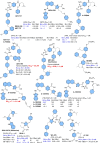Strategies to Reduce the On-Target Platelet Toxicity of Bcl-xL Inhibitors: PROTACs, SNIPERs and Prodrug-Based Approaches
- PMID: 35263486
- PMCID: PMC9311450
- DOI: 10.1002/cbic.202100689
Strategies to Reduce the On-Target Platelet Toxicity of Bcl-xL Inhibitors: PROTACs, SNIPERs and Prodrug-Based Approaches
Abstract
Apoptosis is a highly regulated cellular process. Aberration in apoptosis is a common characteristic of various disorders. Therefore, proteins involved in apoptosis are prime targets in multiple therapies. Bcl-xL is an antiapoptotic protein. Compared to other antiapoptotic proteins, the expression of Bcl-xL is common in solid tumors and, to an extent, in some leukemias and lymphomas. The overexpression of Bcl-xL is also linked to survival and chemoresistance in cancer and senescent cells. Therefore, Bcl-xL is a promising anticancer and senolytic target. Various nanomolar range Bcl-xL inhibitors have been developed. ABT-263 was successfully identified as a Bcl-xL /Bcl-2 dual inhibitor. But it failed in the clinical trial (phase-II) because of its on-target platelet toxicity, which also implies an essential role of Bcl-xL protein in the survival of human platelets. Classical Bcl-xL inhibitor designs utilize occupancy-driven pharmacology with typical shortcomings (such as dose-dependent off-target and on-target platelet toxicities). Hence, event-driven pharmacology-based approaches, such as proteolysis targeting chimeras (PROTACs) and SNIPERs (specific non-genetic IAP-based protein erasers) have been developed. The development of Bcl-xL based PROTACs was expected, as 600 E3-ligases are available in humans, while some (such as cereblon (CRBN), von Hippel-Lindau (VHL)) are relatively less expressed in platelets. Therefore, E3 ligase ligand-based Bcl-xL PROTACs (CRBN: XZ424, XZ739; VHL: DT2216, PZ703b, 753b) showed a significant improvement in platelet therapeutic index than their parent molecules (ABT-263: DT2216, PZ703b, 753b, XZ739, PZ15227; A1155463: XZ424). Other than their distinctive pharmacology, PROTACs are molecularly large, which limits their cell permeability and plays a role in improving their cell selectivity. We also discuss prodrug-based approaches, such as antibody-drug conjugates (ABBV-155), phosphate prodrugs (APG-1252), dendrimer conjugate (AZD0466), and glycosylated conjugates (Nav-Gal). Studies of in-vitro, in-vivo, structure-activity relationships, biophysical characterization, and status of preclinical/clinical inhibitors derived from these strategies are also discussed in the review.
Keywords: Bcl-xL; Bcl-xL inhibitors; PROTACs; SNIPERs; drug conjugates; on-target toxicity; platelet toxicity.
© 2022 The Authors. ChemBioChem published by Wiley-VCH GmbH.
Conflict of interest statement
The authors declare no conflict of interest.
Figures
















Similar articles
-
DT2216-a Bcl-xL-specific degrader is highly active against Bcl-xL-dependent T cell lymphomas.J Hematol Oncol. 2020 Jul 16;13(1):95. doi: 10.1186/s13045-020-00928-9. J Hematol Oncol. 2020. PMID: 32677976 Free PMC article.
-
Discovery of IAP-recruiting BCL-XL PROTACs as potent degraders across multiple cancer cell lines.Eur J Med Chem. 2020 Aug 1;199:112397. doi: 10.1016/j.ejmech.2020.112397. Epub 2020 May 4. Eur J Med Chem. 2020. PMID: 32388279 Free PMC article.
-
Discovery of PROTAC BCL-XL degraders as potent anticancer agents with low on-target platelet toxicity.Eur J Med Chem. 2020 Apr 15;192:112186. doi: 10.1016/j.ejmech.2020.112186. Epub 2020 Feb 27. Eur J Med Chem. 2020. PMID: 32145645 Free PMC article.
-
Recent advances in IAP-based PROTACs (SNIPERs) as potential therapeutic agents.J Enzyme Inhib Med Chem. 2022 Dec;37(1):1437-1453. doi: 10.1080/14756366.2022.2074414. J Enzyme Inhib Med Chem. 2022. PMID: 35589670 Free PMC article. Review.
-
Design and optimization strategies of PROTACs and its Application, Comparisons to other targeted protein degradation for multiple oncology therapies.Bioorg Chem. 2025 Jan;154:107984. doi: 10.1016/j.bioorg.2024.107984. Epub 2024 Nov 22. Bioorg Chem. 2025. PMID: 39591691 Review.
Cited by
-
PROTACs: A novel strategy for cancer drug discovery and development.MedComm (2020). 2023 May 29;4(3):e290. doi: 10.1002/mco2.290. eCollection 2023 Jun. MedComm (2020). 2023. PMID: 37261210 Free PMC article. Review.
-
Anti-apoptotic protein BCL-XL as a therapeutic vulnerability in gastric cancer.Animal Model Exp Med. 2023 Jun;6(3):245-254. doi: 10.1002/ame2.12330. Epub 2023 Jun 4. Animal Model Exp Med. 2023. PMID: 37271936 Free PMC article.
-
PROTAC-mediated dual degradation of BCL-xL and BCL-2 is a highly effective therapeutic strategy in small-cell lung cancer.bioRxiv [Preprint]. 2024 Mar 1:2024.02.27.582353. doi: 10.1101/2024.02.27.582353. bioRxiv. 2024. Update in: Cells. 2024 Mar 17;13(6):528. doi: 10.3390/cells13060528. PMID: 38464204 Free PMC article. Updated. Preprint.
-
PROTAC-Mediated Dual Degradation of BCL-xL and BCL-2 Is a Highly Effective Therapeutic Strategy in Small-Cell Lung Cancer.Cells. 2024 Mar 17;13(6):528. doi: 10.3390/cells13060528. Cells. 2024. PMID: 38534371 Free PMC article.
-
Screening a living biobank identifies cabazitaxel as a strategy to combat acquired taxol resistance in high-grade serous ovarian cancer.Cell Rep Med. 2025 Jun 17;6(6):102160. doi: 10.1016/j.xcrm.2025.102160. Epub 2025 Jun 3. Cell Rep Med. 2025. PMID: 40466638 Free PMC article.
References
Publication types
MeSH terms
Substances
LinkOut - more resources
Full Text Sources
Other Literature Sources
Medical
Research Materials

